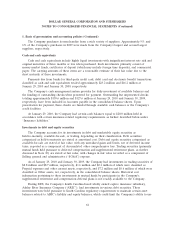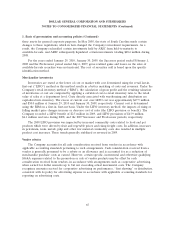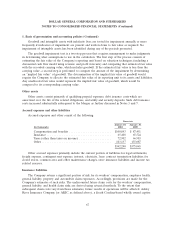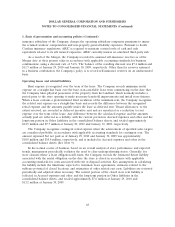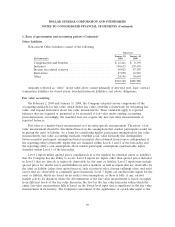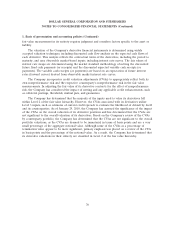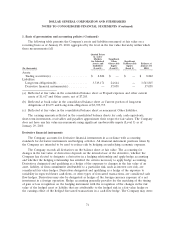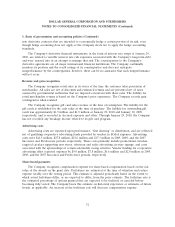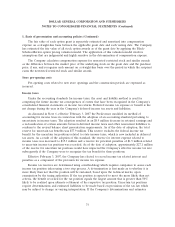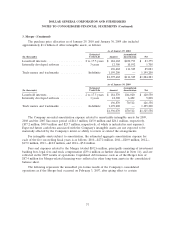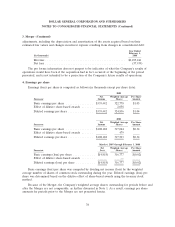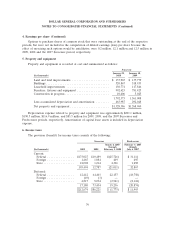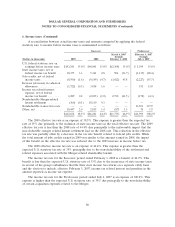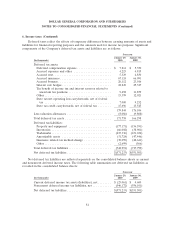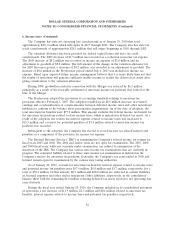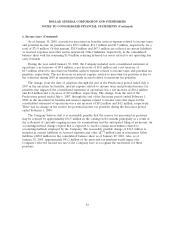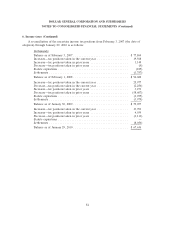Dollar General 2009 Annual Report Download - page 85
Download and view the complete annual report
Please find page 85 of the 2009 Dollar General annual report below. You can navigate through the pages in the report by either clicking on the pages listed below, or by using the keyword search tool below to find specific information within the annual report.DOLLAR GENERAL CORPORATION AND SUBSIDIARIES
NOTES TO CONSOLIDATED FINANCIAL STATEMENTS (Continued)
1. Basis of presentation and accounting policies (Continued)
prove to be inaccurate, the resulting adjustments could be material to the Company’s future financial
results.
Management estimates
The preparation of financial statements and related disclosures in conformity with accounting
principles generally accepted in the United States requires management to make estimates and
assumptions that affect the reported amounts of assets and liabilities and disclosure of contingent assets
and liabilities at the date of the consolidated financial statements and the reported amounts of
revenues and expenses during the reporting periods. Actual results could differ from those estimates.
Accounting standards
In June 2009 the Financial Accounting Standards Board (‘‘FASB’’) issued a new accounting
standard which established the FASB Accounting Standards Codification (‘‘ASC’’) as the source of
authoritative U.S. GAAP recognized by the FASB to be applied by nongovernmental entities. Rules and
interpretive releases of the Securities and Exchange Commission (‘‘SEC’’) under authority of federal
securities laws are also sources of authoritative GAAP for SEC registrants, including the Company. On
September 15, 2009, the effective date of this standard, the ASC superseded all then-existing non-SEC
accounting and reporting standards. All other nongrandfathered non-SEC accounting literature not
included in the ASC became nonauthoritative. The adoption of this statement did not have a material
effect on the Company’s consolidated financial statements.
In June 2009 the FASB issued a new accounting standard relating to variable interest entities. This
standard amends previous standards and requires an enterprise to perform an analysis to determine
whether the enterprise’s variable interest or interests give it a controlling financial interest in a variable
interest entity, specifies updated criteria for determining the primary beneficiary, requires ongoing
reassessments of whether an enterprise is the primary beneficiary of a variable interest entity,
eliminates the quantitative approach previously required for determining the primary beneficiary of a
variable interest entity, amends certain guidance for determining whether an entity is a variable interest
entity, requires enhanced disclosures about an enterprise’s involvement in a variable interest entity, and
includes other provisions. This standard will be effective as of the beginning of the Company’s first
interim and annual reporting periods that begin after November 15, 2009. Earlier application is
prohibited. This standard is not expected to have a material effect on the consolidated financial
statements.
During the second quarter of 2009 the Company adopted the ASC Subsequent Events Topic. The
objective of this topic is to establish general standards of accounting for and disclosures of events that
occur after the balance sheet date but before financial statements are issued or are available to be
issued. In particular, this topic sets forth the period after the balance sheet date during which
management of a reporting entity should evaluate events or transactions that may occur for potential
recognition or disclosure in the financial statements, the circumstances under which an entity should
recognize events or transactions occurring after the balance sheet date in its financial statements, and
the disclosures that an entity should make about events or transactions that occurred after the balance
sheet date. In February 2010 minor modifications were made to this guidance. The adoption of these
standards has not had a material effect on the Company’s consolidated financial statements.
74


